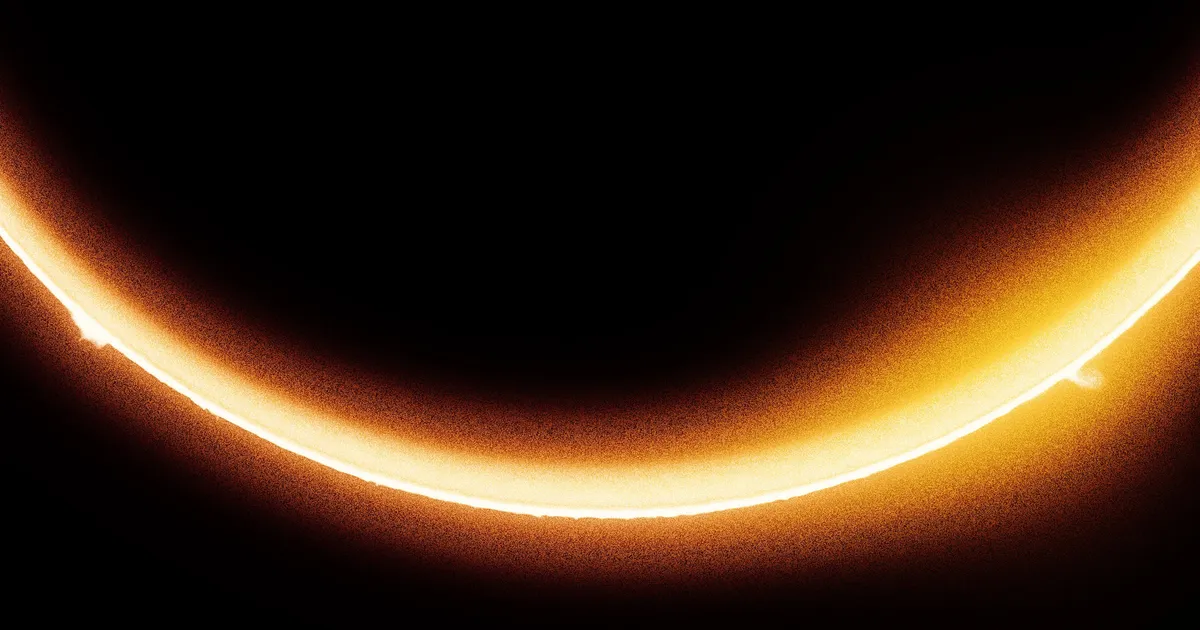
Astronomers have achieved a remarkable milestone by obtaining an unprecedented view of the bottom of the Sun. On Wednesday, the European Space Agency (ESA) unveiled stunning images that showcase the tumultuous beauty of our star's secretive south pole. These groundbreaking images were captured by the Solar Orbiter spacecraft, marking a significant advancement in our understanding of the Sun and paving the way for solving some of its most enduring mysteries. This achievement could also provide valuable insights into the Sun's volatile behavior, which has the potential to disrupt modern infrastructure on Earth.
"Today we reveal humankind's first-ever views of the Sun's pole," stated Carole Mundell, the ESA's director of science. "These unique views from our Solar Orbiter mission signify the beginning of a new era of solar science." Despite the Sun being the cornerstone of our existence, our perspective on it has been embarrassingly limited. Traditionally, we have only been able to observe its equator due to the Earth's unchanging orbit, known as the ecliptic plane, around the star. This restriction has also applied to most of our spacecraft.
Breaking free from the ecliptic plane is a fuel-intensive maneuver. Until now, only the ESA/NASA Ulysses mission, which launched in 1990 and concluded in 2009, managed to reach high enough to observe the Sun's poles. However, this mission lacked the necessary cameras to capture images. To facilitate its groundbreaking observations, the Solar Orbiter executed several flybys of Venus, utilizing gravity assists to gain speed. This allowed the spacecraft to escape the ecliptic plane, achieving a maximum viewing angle of 17 degrees below the solar equator.
As scientists eagerly anticipated these initial observations, they were aware that the Sun's poles remained largely unexplored territory. "We didn't know what exactly to expect from these first observations — the Sun's poles are literally terra incognita," remarked Sami Solanki, director of the Max Planck Institute for Solar System Research in Germany and leader of the scientific team responsible for the Solar Orbiter's onboard instruments.
The orbiter recorded images of the Sun's poles during a unique period in the solar cycle. Currently, the Sun is nearing the end of its solar maximum, an 11-year phase characterized by heightened magnetic activity, resulting in increased solar phenomena such as flares and sunspots. The recent images, taken with the Solar Orbiter's Polarimetric and Helioseismic Imager (PHI), reveal the strongest bands of magnetic activity depicted in dark red and dark blue blotches over the Sun's equator. Notably, the solar maximum culminates in the magnetic field of the Sun flipping, leading to chaotic conditions at the poles.
The PHI view indicates that the southern pole exhibits signs of both north and south polarity magnetic fields, albeit much weaker than those at the equator. This suggests that, at this moment, the Sun lacks a definitive north and south pole. However, this situation is temporary. In approximately five to six years, the Sun is expected to reach its solar minimum, at which point activity will subside, and the poles will likely stabilize, although the exact mechanics of this process remain poorly understood.
After years of data collection with the Solar Orbiter's Spectral Imaging of the Coronal Environment (SPICE) instrument, scientists have begun measuring how solar material traverses the various layers of the Sun. This research is crucial for uncovering the origins of the solar wind, a powerful stream of energetic particles ejected from the Sun that affects the entire solar system.
Exciting developments are on the horizon. The Solar Orbiter has already captured images of the solar north pole, which are anticipated to reach Earth this November. The spacecraft will maintain its current trajectory until December 2026, when it will conduct another flyby of Venus, aiming for an even higher orbit of 24 degrees.
As solar science advances, the Solar Orbiter continues to push the boundaries of our knowledge, providing invaluable insights into the Sun's behavior and its impact on our solar system.